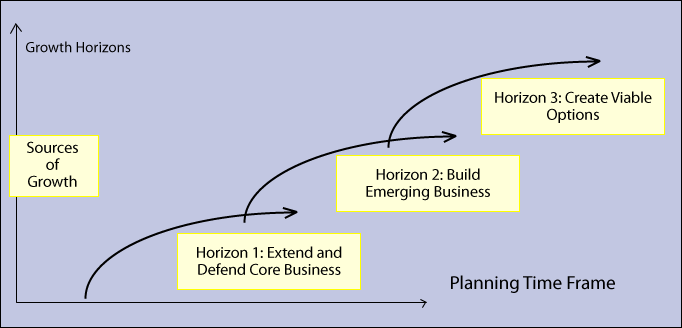Dealing with Interchange: Over the Horizon or Over The Rainbow
One of the most important responsibilities of a leader is to look out over the horizon and detect threats and opportunities, and then translate the vision into action for the organization. This is the essence of strategic planning, and stands in firm opposition to the ‘hope and pray’ school of thought, which is to let competitors and exogenous variables dictate your future, and hope for a pot of gold at the end of the rainbow to solve your problems. Trust me, clicking your heels three times isn’t likely to yield a winning strategy! :-)
Strategic planning outlines the handful of choices that drive the subsequent decisions and actions of the company, and which have the greatest impact on whether objectives will be achieved. Let me start with a definition of strategy, so we’re all on the same page.
Strategy is the direction and scope of an organization over the long-term towards achieving its objectives; which achieves advantage for the organization through its configuration of resources within a challenging environment, to meet the needs of markets and to fulfill stakeholder expectations.
That’s a mouthful – so let’s break it down into the specific questions that strategic planning answers-
- Where is the business trying to get to in the long-term? (direction)
- Which markets should a business compete in and what kinds of activities are involved in such markets? (markets; scope)
- How does the strategy advance the business towards its long-term objectives? (objectives)
- How can the business perform better than the competition in those markets? (advantage)
- What resources (skills, assets, finance, relationships, technical competence, facilities) are required in order to be able to compete? (resources)
- What external, environmental factors affect the businesses' ability to compete? (environment)
- What are the values and expectations of those who have power in and around the business? (stakeholders)
Let’s apply this framework to an issue that every credit union is facing today on the revenue side of the P&L-- what will it mean to your business model to have dramatically reduced revenue from interchange?
I’m not going to delve into the question of whether or not Congress is going to act to delay or repeal interchange. It is irrelevant for purposes of strategic planning -- you should treat the current proposal as a ‘most likely’ scenario and use strategic planning to develop your ‘Plan B,’ to identify growth opportunities to replace lost revenue. 1
It may be helpful to provide a framework with some visuals. So divide your future into three general time horizons – near-term, mid-term, and long-term. More specifically --
- Near-term: strategic initiatives related to existing core business
- Mid-term: leveraging opportunities that are already visible
- Long-term: actions taken today that enable options for future growth
[caption id="attachment_194" align="alignnone" width="682" caption="CREDIT: ‘Enduring Ideas: The three horizons of growth’, Steve Coley, Director Emeritus, McKinsey and Company, McKinsey Quarterly, December 2009"] [/caption]
[/caption]
You will note that each is defined without using specific time yardsticks. This is because the cycles can vary tremendously depending on what you are looking at – compare developing an iPhone app versus building a new branch, for example. H3 can be 12 months for the former, and three years for the latter. So you may well have multiple versions of this planning framework within your credit union, all of which need to get rolled up into a consolidated strategic framework, expressed through your budget process.
Think of investments relating to the long-term (H3 in the chart) almost like basic research – they have no immediate impact on the bottom line but we believe they will give us some opportunities going forward. For a credit union, it might be research into where your members are to assess whether and where you can establish new profitable branches. Or it might be market research to see which new revenue-generating solutions your members might want (GAP, MBP, Debt Protection, ID Theft protection, foreign exchange, etc., etc.). It could also be training to develop skill sets you will need in the future, or due diligence on possible merger partners.
You can also think of H3 investments as creating options for your future. There is a concept in entrepreneurship called the corridor principle. If you look down a hallway, all you see is carpet and a wall way down at the far end. But if you walk down that hall, you see doors on either side of you – each one represents a potential opportunity. Had you not walked down that hall you would never have seen any of the doors. An H3 investment lets you walk down the hall and look at all the doors – don’t walk down the hall, and you don’t even have the option to enter any of the rooms.
The investment in H3 is like walking down that hall – it gives you visibility into the most promising opportunities, which allows you to make more targeted investment decisions in H2. Staying with our example, let’s say that your market research shows that members are concerned about job security, and that represents a key barrier impeding loan growth. H2 investments to build the business could be implementation and deployment costs (from HR to IT to marketing) for debt protection or other solutions that both generate revenue and help address member concerns.
Having decided to pursue the opportunity in H2, you have now created a revenue stream and are investing to extend and defend the core business in H1. This might entail additional marketing expenses, new sales resources, sales training, and/or tweaking of the platform to reflect competitive responses in the markets in which you compete.
For interchange, strategic planning for your ‘Plan B’ should start with looking out over the horizon -- asking the questions noted above for H3 in the context of generating net new revenue and meeting member needs. The question about resources (What resources – skills, assets, finance, relationships, technical competence, facilities – are required in order to be able to compete?) will dictate what sort of H3 investments and activities are required.
1 Before Fred or Dan Berger email me, this does not mean that you should let up one iota in your efforts to contact your Congressional delegation on the interchange issue, because the issue is truly not yet decided. Go to www.saveyourdebitcard.com for more information.
Related Resources:
- The Future of Debit Cards: How to Prepare for Significant Losses in Interchange Income NAFCU webcast.
- Debt protection solutions: www.nafcu.org/Securian
- Other Preferred Partner solutions offering growth opportunities: www.nafcu.org/growthandretention
Post written by David Frankil, President, NAFCU Services Corporation

